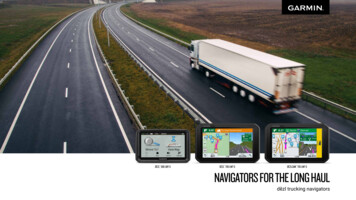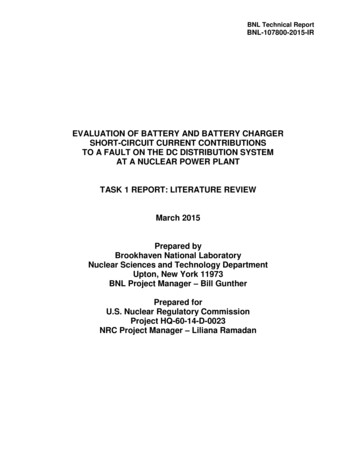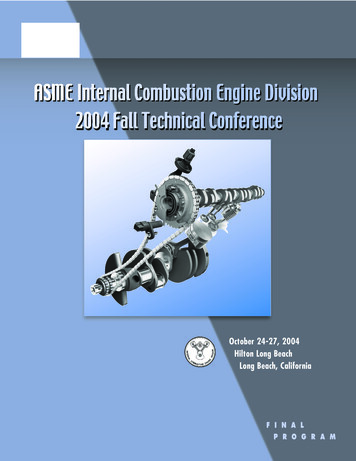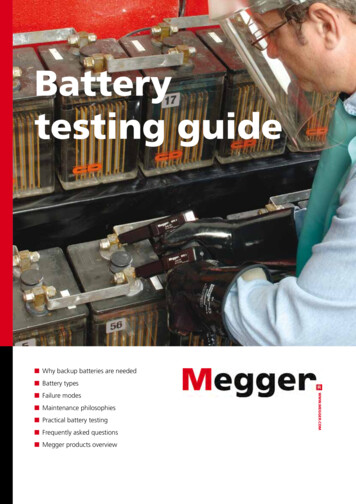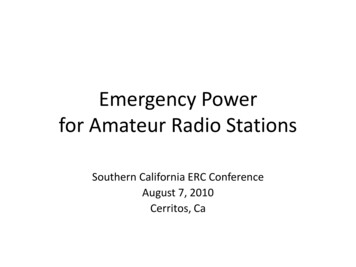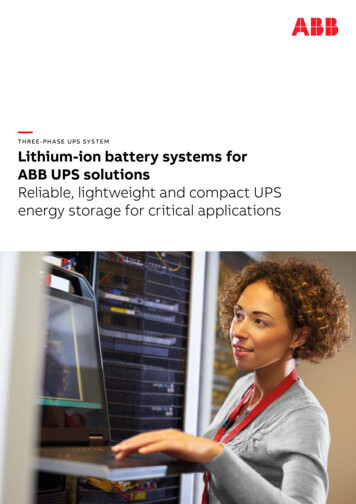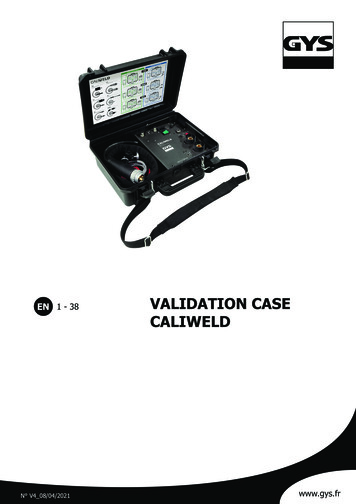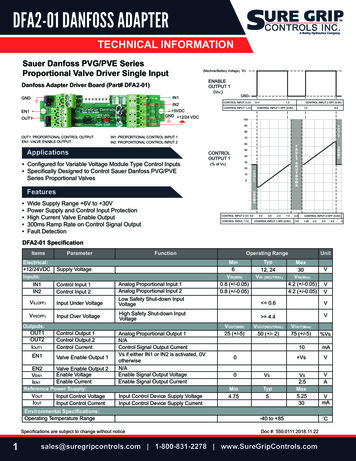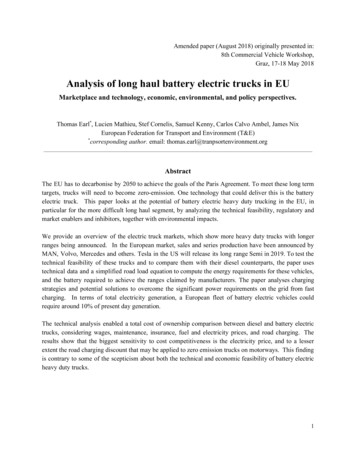
Transcription
Amended paper (August 2018) originally presented in:8th Commercial Vehicle Workshop,Graz, 17-18 May 2018Analysis of long haul battery electric trucks in EUMarketplace and technology, economic, environmental, and policy perspectives.Thomas Earl * , Lucien Mathieu, Stef Cornelis, Samuel Kenny, Carlos Calvo Ambel, James NixEuropean Federation for Transport and Environment (T&E)* corresponding author. email: thomas.earl@tranpsortenvironment.orgAbstractThe EU has to decarbonise by 2050 to achieve the goals of the Paris Agreement. To meet these long termtargets, trucks will need to become zero-emission. One technology that could deliver this is the batteryelectric truck. This paper looks at the potential of battery electric heavy duty trucking in the EU, inparticular for the more difficult long haul segment, by analyzing the technical feasibility, regulatory andmarket enablers and inhibitors, together with environmental impacts.We provide an overview of the electric truck markets, which show more heavy duty trucks with longerranges being announced. In the European market, sales and series production have been announced byMAN, Volvo, Mercedes and others. Tesla in the US will release its long range Semi in 2019. To test thetechnical feasibility of these trucks and to compare them with their diesel counterparts, the paper usestechnical data and a simplified road load equation to compute the energy requirements for these vehicles,and the battery required to achieve the ranges claimed by manufacturers. The paper analyses chargingstrategies and potential solutions to overcome the significant power requirements on the grid from fastcharging. In terms of total electricity generation, a European fleet of battery electric vehicles couldrequire around 10% of present day generation.The technical analysis enabled a total cost of ownership comparison between diesel and battery electrictrucks, considering wages, maintenance, insurance, fuel and electricity prices, and road charging. Theresults show that the biggest sensitivity to cost competitiveness is the electricity price, and to a lesserextent the road charging discount that may be applied to zero emission trucks on motorways. This findingis contrary to some of the scepticism about both the technical and economic feasibility of battery electricheavy duty trucks.1
Finally, this paper lays down the necessary policy recommendations to facilitate and expedite electrictrucking uptake are suggested, namely: CO 2 standards for trucks and trailers; a zero emission vehicle(ZEV) mandate for trucks; electricity pricing; road charges, tolls, and fuel taxes; zero-emission freightstrategies for cities; infrastructure; the reform of the weights and dimensions directive, including payloadallowance, and battery manufacturing.2
1. IntroductionThe greenhouse gas emitted from trucks moving freight in Europe is responsible for around 20% of roadtransport emissions [1] . In accordance with the Paris Agreement, the European Union has regulations inplace to ensure that all sectors of the economy contribute to decarbonisation. By 2030, non-ETS sectorssuch as transport will need to cut emissions by 30% compared to 2005. In the longer term, the emissionreduction target for all sectors in 2050 is in the range of 80% to 95% compared to 1990 levels - transportshould achieve 94% [2] . As some sectors in transport are more difficult to completely decarbonise (suchas aviation), in order to meet these reductions, it is imperative that all road vehicles combusting fossilfuels be replaced by zero-emission vehicles.Electric trains offer the greenest and one of the most energy efficient means of transporting goods. WhileEurope has an extensive network of railway infrastructure, passenger trains generally enjoy priority overfreight, leading to lower punctuality for freight trains on busy routes. The EU has identified dedicatedfreight corridors to be improved under the TEN-T framework1 and, with very robust investment andreform, it may be possible for rail to increase its current market share of 18% of surface freight to 23%[3] . Owing to the flexibility of trucks, their speed, cost advantage, and the overhaul needed in the railsector to realise its maximum potential, road transport is likely to maintain a market share not greatlydissimilar from its 75% level today [4]2. For these reasons, this paper focuses on the solutions available todecarbonise the trucking sector.The European Commission’s Reference Scenario [5] predicts increasing transport demand; consideringmarginal fuel efficiency improvements of new trucks, this will result in increasing GHG emissions asobserved historically3. To curb these emissions from their current upward trajectory, the EuropeanCommission will table truck standards in May 2018. These standards will not only help meet Europe’sclimate targets, but are expected to boost emission-reduction technological improvements, such as morefuel efficient engines, aerodynamics, and high performance tyres. This of course all depends on thestringency of the standard. When combined with other current measures, including reduced road chargesfor zero emissions vehicles, the upcoming package of measures should incentivise new, zero emissionsdrivetrains. Although more efficient trucks are a step in the right direction, trucks running on fossil fuelwill continue to produce GHG emissions.One report [6] on decarbonising road freight found that direct electric trucks are the most energy efficientsolution for decarbonisation. E-highway4 technology being developed by Scania and Siemens is anexample of how to decarbonise long haul freight. E-highways are an intriguing proposition and may bemore cost effective than BETs for long haul trucking (including infrastructure building), as indicated by[7] - the ongoing trials in Sweden and Germany show that they are already technically feasible. Otherzero emission technologies, namely hydrogen fuel cells and power to liquid ‘drop-in’ fuels for internal1234 https://ec.europa.eu/inea/en/ten-t/ten-t-projects http://lowcarbonfreight.eu/ /freight-transport-demand-version-2/assessment-7 oad-solutions/electromobility/ehighway.html3
combustion engines, would require 3 to 5 times more electricity than a pure electric drivetrain. In thesimplest terms, this would result in an equivalent cost increase factor for the energy/fuel. The report’saddendum considered the impact of using BETs for long-distance transport (rather than e-highways),arriving at the key conclusion that current trip lengths in the EU mean that the main technical hindrance tobattery electric trucking in the EU would be a charging network. Before the unveiling of the Tesla Semi,[8] carried out an analysis that rather dampened the expectations of BETs for long haul, showing that withcurrent technology, batteries would be too heavy and too costly for long range trucks.In recent years BETs have become viable, zero tailpipe emission alternatives to diesel fuelled trucks. As aresult, an increasing number of models have been announced accompanied with the release of technicalspecifications, such as range and air drag coefficient, and importantly their prices. These data enable acomparison between diesel trucks on the roads today to be carried out, and the following sectionsessentially compare BET and diesel trucks from technological and economic standpoints.This report aims to understand the economic and logistic business cases for battery electric trucks, to seewhether BET is a technology that Europe should be promoting as a solution to decarbonise the roadfreight sector. To begin with, an overview of the current truck market is provided. Following that, acomprehensive comparison between a battery electric truck with a diesel ICE truck in long haul operationis undertaken. Consideration will be given to the technical, economic, and regulatory enablers for heavyduty trucks in a European context. We aim to find if there is a market case for battery electric trucks, andto identify the policies that will tip the scales in favour of zero emissions heavy duty trucks in the EU.Finally, the environmental benefits of electric trucks will be investigated.2. BETs in the marketplaceThe conditions for battery electric trucks (BETs) have drastically changed since 2010, a year whenlithium-ion battery prices were around US 750-1000/kWh [9] with energy densities of around 110Wh/kg5. Compared to 2018, prices have come down by around a factor of four, and densities have morethan doubled. In simple terms, batteries are cheap and dense enough to be considered as viable forpowering trucks. These trends in the reduction in cost and improvement in specific density has lead to(and conversely been driven by) a rapid increase in both passenger electric vehicles (surpassing 2 millionsales globally [10] ), electric urban buses, and the emergence of heavy duty trucks.Perhaps the first BETs to come to market in large scale were garbage trucks - ideal candidates forelectrification owing to their predictable routes and stop-start operation (which is where internalcombustion engines, ICEs, are particularly inefficient and noisy). A notable example of the deployment ofelectric garbage trucks occured in preparation for the Beijing Olympics in 2008, where 3000 garbagetrucks were replaced with battery electric variants to reduce noise and pollution. China has also been atthe forefront of electrifying its urban bus fleets, notably in Shenzhen, where the entire fleet of over16 000 buses was electrified with batteries6. With this investment, BYD and the city clearly see theviability and benefit of battery electric heavy duty vehicles.56 batteryuniversity.com/learn/archive/the high power lithium ion ional-bus-fleet/4
In continental Europe, the battery electric Emoss began converting diesel trucks to BETs in theNetherlands in 2012 for a number of Dutch companies. In Switzerland in 2014, an 18t E-Force One truckbegan operations for the supermarket chain Coop7. More recently traditional truck makers also madeannouncements to enter the market. In early 2018 both MAN and Mercedes8 placed pilot e-trucks withcustomers. Volvo9,10, with the 16t FL Electric, and Renault have announced that they will start sellingelectric trucks by 2019. In the case of the Volvo, there is a claimed range of 300 km. VDL has partneredwith MAN to develop a 37 t truck, however the range is mainly targeted for deliveries, at 100 km. Inshort, current announcements in Europe tend to be for urban deliveries and often smaller payloads.The long haul and larger segment sectors are technically more challenging than the urban delivery trucksegment. Trucks are driven further between towns and cities, and they also tend to require a largerpayload capacity. To accommodate these higher demands, Nikola Motors has announced a BET withhydrogen fuel cell range extender11 and Toyota a hydrogen fuel cell truck12. However, othermanufacturers see the potential of BETs in the long haul sector too. Notably, US company Tesla unveiledits battery powered class 8 truck13 in late 2017 and Chinese manufacturer BYD14 added long haul trucks toits increasing offering of electric trucks in 2016.3. Technical comparison15The main aim of this section is to determine how much energy a heavy duty BET will need to transportcargo across the continent, and how this compares with its diesel counterpart. Independent of powertrainor range, we define a tractor trailer truck in this analysis as having a gross vehicle weight (GVW) of 40tonnes and a frontal area of 10 m 2 (from a width, W 2.5 m and a height, H 4 m). We define two ICEdiesel trucks, one that represents the performance of the fleet, and a best-in-class truck that will moredirectly be compared to the BET. Likewise, two class 8 BETs will be considered, namely the Tesla Semiand the BYD Q3M.The fleet average fuel consumption of recently-manufactured (i.e. circa 2015) long-distance 40 t trucks inthe EU is 33 L/100km [11] . This number not only encompasses all driving conditions, from the extremecases of flat, straight-line driving in the Netherlands, mountainous driving in countries such as Austria, tostop-start driving in cities, but also the varying mass of freight being transported by the trucks, which runempty almost a quarter of the time, on average [12] . Modelling this fuel consumption would require arange of real-world speed and inclination profiles and engine maps. In lieu of this, we define the second78 zen-auf-Elektro-Lastwagen-23057287 ros.html 2.html -electric-truck-the-fl-electric?iid sr-link511n ikolamotor.com/one12c orporatenews.pressroom.toyota.com/releases/toyota zero emission heavyduty trucking concept.htm91013www.tesla.com/semi/ .pdf15 This section takes inspiration and uses values from [11] and this piece of analysis from Chris -semi-part-1/)145
ICE, that has a performance which is best in class and thus has a known maximum efficiency that ispossible to analyse analytically, as will be shown below.Figure 1: Main resistive forces to forward motion from the simplified road load equationThe two main forces working against the truck’s forward motion, namely the aerodynamic drag and therolling resistance of the tyres, are collectively known as the “road load” and we denote them as F RL . Toperform the analytical comparison between the best in class ICE and BET, we use a simplified version ofthe road load equation which assumes a constant speed, a flat
We provide an overview of the electric truck markets, which show more heavy duty trucks with longer ranges being announced. In the European market, sales and series production have been announced by MAN, Volvo, Mercedes and others. Tesla in the US will release its long range Semi in 2019. To test the technical feasibility of these trucks and to compare them with their diesel counterparts, the .
